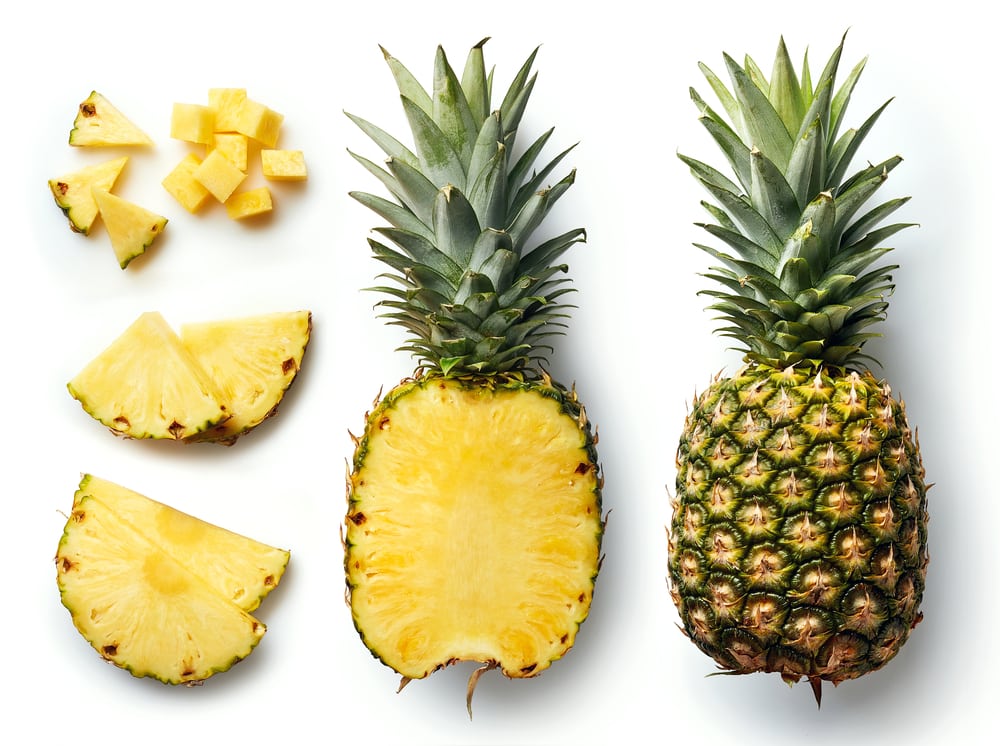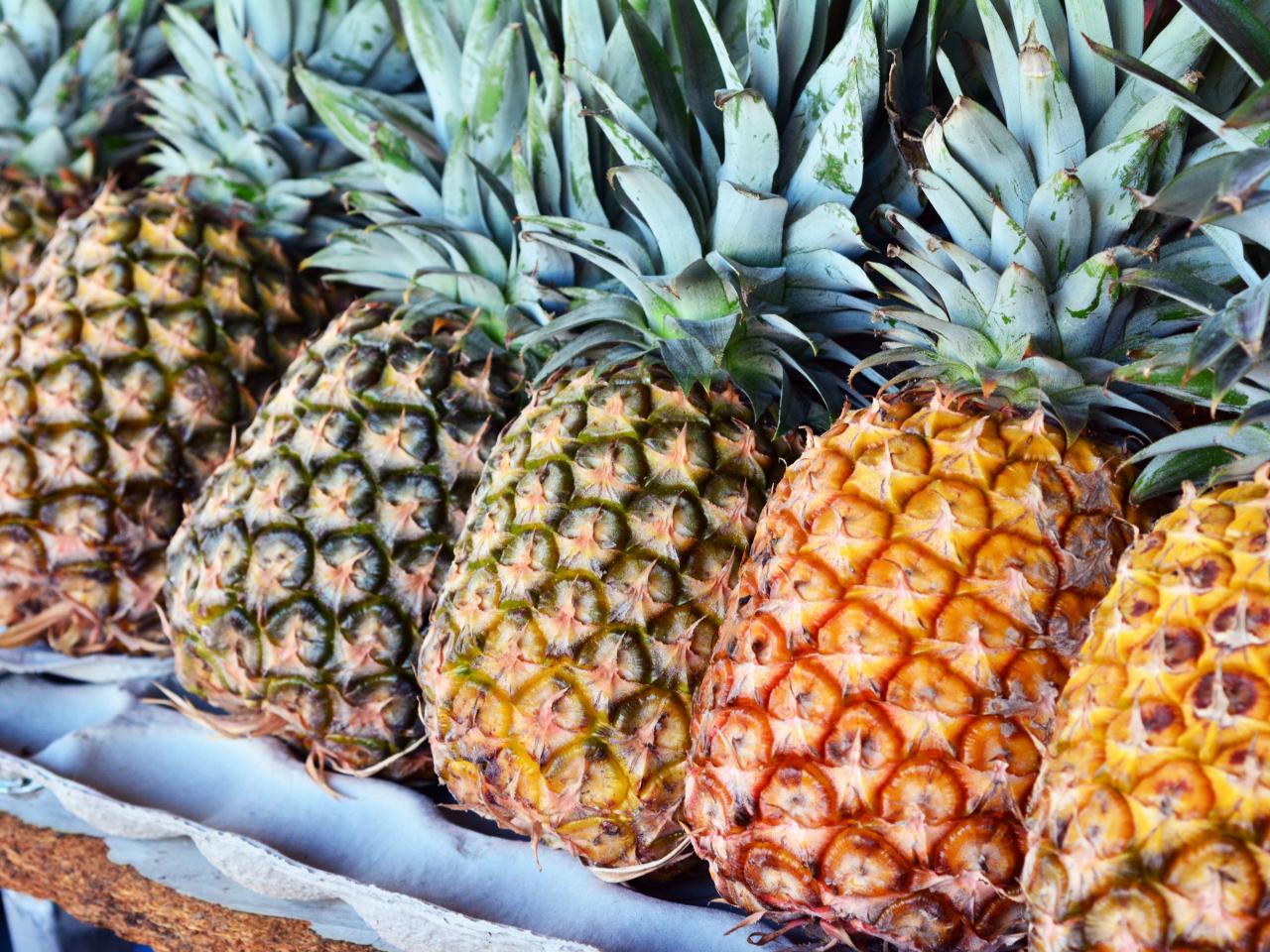To tell if a pineapple is bad, check for soft spots, mold, and an unpleasant odor. A fresh pineapple should feel heavy, firm, and have a sweet aroma at the base.
Selecting the perfect pineapple can be akin to uncovering a tropical treasure, key not only for flavor but also health benefits like vitamin C and digestion-friendly enzymes. Knowing how to spot a spoiled pineapple ensures that your fruit experience is always at its peak, whether for snacking, grilling, or smoothing into a refreshing beverage.
A ripe pineapple boasts a sturdy, green crown and a golden-yellow shell, while one past its prime often has dull leaves, darkened skin, and a withering presence. Embracing these tips when choosing pineapples aligns with healthy eating habits and culinary success, transforming an everyday grocery run into a quest for vibrant, juicy perfection.

Fresh Vs. Spoiled Pineapple
Choosing a pineapple at the grocery store can be tricky. A ripe, fresh pineapple is sweet and juicy. A spoiled one is not a pleasant experience. Let’s dive into the details to ensure every pineapple you bring home is the best it can be.
Characteristics Of A Fresh Pineapple
- Color: A fresh pineapple shows a healthy green crown. Its skin boasts a golden-yellow hue. Look for an even color distribution.
- Texture: The skin should be firm. It should give slightly to pressure. The eyes are uniform in size.
- Smell: Sniff the base of the pineapple. A sweet, fruity scent is your green light. An aroma that suggests ripeness is ideal.
- Leaves: Green, vibrant leaves suggest vitality. They should be firmly attached.
- Weight: A good pineapple feels heavy for its size. Heft indicates juiciness.
Common Signs Of Spoilage
- Discoloration: Brown, dark spots on the skin may signal decay. Avoid if they are widespread.
- Texture: Soft spots or mushiness are red flags. They can indicate overripeness or rot.
- Smell: An off or sour smell is a clear sign of spoilage. A vinegary or fermented scent means it’s bad.
- Leaves: Wilted, brown leaves hint at an old pineapple. They should not pull out easily.
- Mold: Fuzzy, grayish-green growths spell trouble. Mold means the pineapple is no longer good.
A fresh pineapple becomes a tropical treat. A spoiled one poses risks and ruins flavors. Use these pointers to distinguish one from the other. Your taste buds and recipes will thank you.

Visual Cues For Pineapple Quality
Visual cues play a crucial role in determining the quality of a pineapple. Fresh pineapples boast a vibrant appearance, firm structure, and a sweet aroma. To avoid selecting a pineapple past its prime, it’s important to know the signs that indicate spoilage. Observing a pineapple carefully can help you distinguish a ripe, juicy fruit from one that’s better left behind.
Color Changes To Watch For
A healthy pineapple shows a golden-yellow hue from bottom to top. An unripe pineapple has a greener color, while an overripe one turns dark yellow or brown. Below are the specific color changes to keep an eye on:
- Green Base: If the base is green, it likely needs more time to ripen.
- Yellow Body: A uniform yellow color signifies ripeness and readiness to eat.
- Brown Leaves: Darkening of the leaves may indicate aging, proceed with caution.
- Brown Spots: Brown spots on the skin suggest overripening or bruising.
Mold And Its Implications
Mold growth is a definitive sign a pineapple is no longer safe to consume. Search for these indicators:
- White Fuzz: This is early-stage mold, often appearing where the fruit has been bruised.
- Black or Green Spots: These colors of mold suggest significant spoilage and potential health risks.
- Mushy Texture: Mold-affected areas typically turn soft and should be avoided.
| Sign of Spoilage | Implication |
|---|---|
| White Fuzz | Early-stage mold, potential to recover if cut away. |
| Dark Spots | Advanced mold, discard the fruit. |
| Mushy Areas | Denotes decay, not safe to eat. |
Texture And Firmness
When picking a pineapple, its texture and firmness are key indicators of freshness. These characteristics offer clues about the pineapple’s ripeness and overall quality. A ripe pineapple should feel firm but yield slightly under pressure. Understanding the texture and firmness will help ensure you select a pineapple that’s perfect for eating. Let’s dive into how you can identify the ideal texture of a pineapple and what soft spots might indicate.
Ideal Pineapple Texture
The perfect pineapple boasts a specific texture that signals it’s ripe and ready to eat. Its skin should be firm to the touch with a slight give. The leaves should be fresh and green, indicating that the pineapple hasn’t passed its peak. A well-textured pineapple has eyes that are flat and even across its surface, which suggests sweetness and maturity.
What Soft Spots Can Tell You
Soft spots on a pineapple can reveal a lot about its condition. Small, shallow soft areas might simply be minor bruises – often not a concern. However, large, deep soft spots are red flags. They may indicate over-ripeness or decay. Consistent firmness is key; a pineapple yielding too easily to pressure could be past its prime. An uneven texture with multiple soft areas often suggests internal spoilage. Always avoid pineapples with these traits to ensure you get a fresh, delicious fruit.
Smell And Taste Tests
Wondering whether your pineapple is still good to eat? Two of the best ways to tell are through smell and taste tests. Before slicing into the pineapple, these simple steps can help you decide if it’s ripe or if it’s time to toss it out.
The Scent Of Freshness Versus Fermentation
A healthy pineapple has a sweet, tropical aroma. It smells fresh and inviting. On the other hand, a bad pineapple gives off an unpleasant odor. This can range from a sour smell to an alcoholic or vinegar-like aroma. These scents suggest fermentation has started.
Taste Differences In Spoiled Pineapples
Even the slightest taste of a spoiled pineapple is enough to tell it’s not good. A fresh pineapple tastes sweet with a tropical zing. A spoiled pineapple tastes off; it can be very sour or even have a fizzy, sharp taste due to fermentation.
Storage Tips To Prolong Freshness
Knowing the right storage tricks is vital to keep pineapples fresh longer.
To maintain that tropical flavor, proper steps are essential. These tips ensure your pineapple stays ripe and ready-to-eat.
Optimal Conditions For Storage
Where and how you store pineapples can make a big difference. Here’s how to do it:
- Keep it cool: A ripe pineapple does best in a fridge, ideally at 45–55°F (7–13°C).
- Avoid moisture: Pineapples don’t like too much humidity, so keep them dry.
- Upright position: Store pineapples standing up to prevent bruising and spoilage.
Effect Of Storage Method On Spoilage
Storage method heavily impacts how long a pineapple stays good.
Know the effects:
| Method | Shelf Life |
|---|---|
| Room temperature | 1–2 days |
| Refrigerator | 3–5 days |
| Freezer (chunks) | Up to 6 months |
Remember:
- Room temperature: It will spoil faster.
- Refrigerator: Good for short-term storage.
- Freezer: Best for long-term, but alters texture.
Correct storage is key to enjoying a sweet and juicy pineapple. Take these steps for the best taste and minimal waste.
Healthy Consumption Practices
Eating ripe and fresh fruit is key to a healthy diet. Spotting a bad pineapple ensures you get the most out of this tropical treat. Recognizing signs of spoilage in pineapples can be easy with the right knowledge. Not only does this guarantee you enjoy the vibrant taste and nutritional benefits, but it also contributes to food safety and reduces waste. Let’s dive into how you can identify a pineapple that’s past its best.
Food Safety With Pineapples
Pineapples host abundant nutrients, but when they turn bad, they can pose health risks. Follow these signs to ensure food safety:
- Smell the pineapple: A bad one has a sour or fermented odor.
- Check the firmness: If it feels soft, it may be spoiled.
- Look at the color: Dark spots can mean decay.
- Inspect the leaves: Wilted leaves indicate a lackluster fruit.
Preventing Fruit Waste
Avoiding fruit waste is good for both the environment and your wallet. Use these tips:
- Buy what you need: Choose the right size pineapple for your needs.
- Store properly: Keep it in the fridge if you’re not eating it right away.
- Use visual cues: Use pineapples at peak ripeness for best taste.
- Repurpose overripe fruit: Make smoothies or baked goods with it.

Frequently Asked Questions Of How To Tell If A Pineapple Is Bad
What Signs Indicate A Pineapple Is Bad?
Rotten pineapples exhibit certain signs including softness, dark spots, and an unpleasant odor. If it feels mushy or has visible mold, it’s best to discard it. Additionally, a sour or fermented smell indicates spoilage.
Can You Eat An Overripe Pineapple?
While overripe pineapples are not necessarily bad, they may taste overly sweet and lose their characteristic tang. However, if the pineapple shows signs of fermentation or mold, avoid consumption as it could lead to food poisoning.
How Long Does A Pineapple Stay Fresh?
A fresh pineapple typically stays good for 2-3 days at room temperature or up to a week when refrigerated. Once cut, it should be eaten within 3-4 days for optimal taste and food safety.
Does A Pineapple Have To Be Refrigerated?
Whole pineapples do not require refrigeration and can be kept at room temperature until cut. After cutting, store pineapple in an airtight container in the refrigerator to maintain freshness.
Conclusion
Recognizing a bad pineapple is simple with these tips. Ensure your fruit stays fresh by checking texture, color, and smell. Discarding spoiled pineapples is crucial for health. Remember, a good pineapple means vibrant flavor and safe eating. Enjoy your fruit, the right way!

